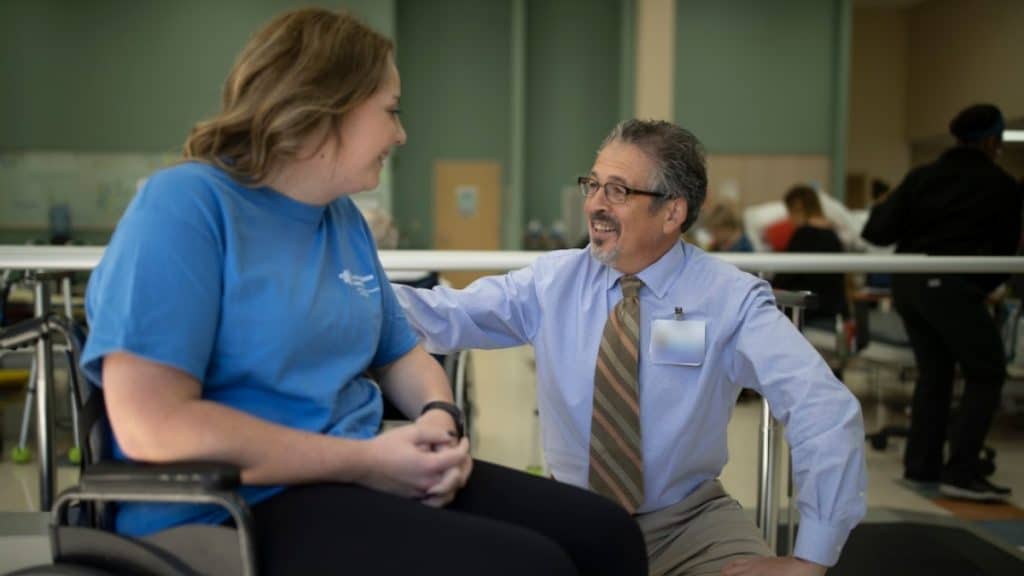A stroke can be a life-altering event, but it doesn’t have to define the rest of your life. Rehabilitation is a crucial step in regaining your independence and improving your quality of life after a stroke. Inpatient rehabilitation offers a patient-centered approach that provides intensive, personalized care to help stroke survivors recover faster and more effectively. In this article, PAM Health will explore the benefits of inpatient rehabilitation for post-stroke recovery, highlighting its importance for stroke survivors and healthcare professionals.
Understanding Inpatient Rehabilitation
Definition and Goals of Inpatient Rehabilitation
Inpatient rehabilitation is a specialized form of care that provides intensive therapy to stroke survivors in a hospital or dedicated rehabilitation facility. The primary goal is to help patients regain their physical, cognitive, and emotional abilities to the highest possible level. This type of rehabilitation involves a structured program that includes various therapies and services designed to address each patient’s unique needs.
Types of Therapies and Services Offered
Inpatient rehabilitation centers offer therapies and services, including physical, occupational, speech-language, and neuropsychological support. Physical therapy focuses on improving strength, balance, and coordination, while occupational therapy helps patients regain the skills needed for daily activities.
Speech-language therapy addresses communication and swallowing difficulties; neuropsychological support helps manage emotional and cognitive challenges.
Benefits of Inpatient Rehabilitation for Stroke Survivors
Faster Recovery and Improved Functional Abilities
One of the most significant benefits of inpatient rehabilitation is the potential for faster recovery. Intensive therapy sessions, personalized care plans, and a supportive environment significantly improve functional abilities. Patients often see significant progress in mobility, strength, and overall independence within a shorter period than outpatient or home-based rehabilitation.
Enhanced Safety and Reduced Risk of Complications
Inpatient rehabilitation provides a safe and structured environment where patients can focus on their recovery without the distractions and risks associated with being at home. The presence of medical professionals ensures that any complications or health issues are promptly addressed, reducing the risk of further injury or setbacks. This level of care is particularly important for stroke survivors who may have complex medical needs.
Personalized Care and Support for Mental Health
Mental health is a critical component of post-stroke recovery, and inpatient rehabilitation centers are well-equipped to address this aspect. Patients receive personalized care that includes counseling and support to help them cope with the emotional challenges of stroke recovery. This holistic approach ensures that physical and mental health needs are met, promoting overall well-being and a more successful recovery.
The Role of Caregivers in Inpatient Rehabilitation
Support and Education Provided to Caregivers
Inpatient rehabilitation centers recognize caregivers’ vital role in the recovery process. These facilities offer support and education to caregivers, ensuring they have the knowledge and resources to assist their loved ones effectively. Caregivers receive training on providing physical and emotional support and guidance on managing the practical aspects of post-stroke care.
Importance of Caregiver Involvement in the Rehabilitation Process
Active caregiver involvement in rehabilitation is crucial for the patient’s recovery. Inpatient rehabilitation programs encourage caregivers to participate in therapy sessions and care planning meetings. This involvement helps caregivers understand the patient’s progress and enables them to provide consistent support once the patient returns home. It also fosters a sense of partnership and collaboration between caregivers and healthcare professionals.
Challenges and How They’re Addressed
Financial and Insurance Challenges
One of the significant challenges associated with inpatient rehabilitation is the cost of care. However, many facilities offer financial counseling and assistance to help patients and their families navigate insurance coverage and payment options. Exploring all available resources and speaking with the facility’s financial advisors is essential to understand the costs and potential financial support options.
Overcoming Physical and Emotional Barriers
Stroke survivors often face physical and emotional barriers that can hinder their recovery. Inpatient rehabilitation centers address these challenges by providing comprehensive care that includes physical therapy, counseling, and support groups. These services help patients build strength, resilience, and confidence, enabling them to overcome obstacles and achieve their recovery goals.
Access to Specialized Equipment and Facilities
Inpatient rehabilitation centers are equipped with specialized equipment and facilities not typically available in outpatient settings. These resources enable patients to receive advanced therapies and treatments, significantly enhancing their recovery. Access to state-of-the-art technology and facilities ensures that patients receive the highest level of care and support.
The Future of Post-Stroke Rehabilitation
Advancements in Rehabilitation Technology
The field of rehabilitation is continually evolving, with new technologies and treatments being developed to improve patient outcomes. Inpatient rehabilitation centers are at the forefront of these advancements, incorporating cutting-edge technology such as robotics, virtual reality, and telemedicine into their programs. These innovations offer new opportunities for stroke survivors to achieve their recovery goals more effectively.
Personalized Medicine and Precision Rehabilitation
Personalized medicine and precision rehabilitation are emerging trends in post-stroke care. These approaches involve tailoring rehabilitation plans to each patient’s needs based on their genetic makeup, medical history, and specific recovery goals. Inpatient rehabilitation centers are increasingly adopting these methods to provide more targeted and effective care.
The Importance of Ongoing Research and Clinical Trials
Ongoing research and clinical trials are vital in advancing post-stroke rehabilitation. Inpatient rehabilitation centers frequently engage in these studies, aiding in the development of innovative treatments and therapies. Patients opting for inpatient rehabilitation may have the chance to participate in clinical trials, accessing state-of-the-art treatments while contributing to the expansion of medical knowledge.
Final Thoughts
As we read in this PAM Health article, inpatient rehabilitation offers a comprehensive, patient-centered approach to post-stroke recovery that addresses physical and mental health needs. By providing intensive therapy, personalized care, and a supportive environment, inpatient rehabilitation centers help stroke survivors achieve faster recovery and improved quality of life. The education and support these facilities provide are invaluable for caregivers in ensuring the best possible outcomes for their loved ones.

